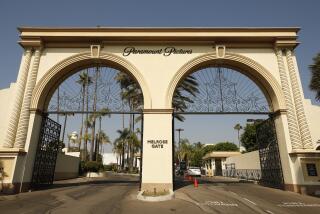British Owners of Panavision Hurt by Bad Timing
- Share via
Last Oct. 13, former film lighting electricians John and Benny Lee seemed to be on top of the world.
The British brothers had just bought Panavision, the Tarzana company that supplies 35-millimeter cameras and accessories to cinematographers in the movie and TV industry. That same day, the Lees bought out the public shareholders of Lee International, their London entertainment services conglomerate. The two deals cost $327 million.
The Lee brothers, already successful from supplying lighting and other film-making equipment in Europe, were now ready to make a big push into the U.S. market. They consolidated their various operations under a new parent company, Westward Communications, as they moved west into the United States.
But the Lees’ timing was terrible. Six days after they bought Panavision from department store heir Frederick W. Field, the American stock market crashed, effectively snuffing out plans to sell stock in their company to help pay off their debts.
Then the five-month writers strike hurt Panavision’s business. Rival camera equipment executives estimate that Panavision’s sales are down 20% this year.
Says It’s Meeting Obligations
As a result of the financial strain, Westward Communications is reviewing its assets, thus triggering speculation about what might happen to Panavision and its other holdings.
Two weeks ago, the Sunday Times of London reported that Westward was “struggling to meet interest and principal repayments” to Citicorp, the lead bank in the consortium that loaned the Lees $327 million. Joan Urbaniak, a spokesperson for Lee-Panavision International in Burbank, as the brothers’ Western regional headquarters is now called, said Westward is meeting its obligations to Citicorp.
“This writers strike made us look at our assets and look at a possible reorganization. We have no plans to sell off major assets at this time,” she said. Will Lee sell Panavison? “Definitely not,” Urbaniak said.
On Friday, about $122 million of Westward’s loan must be repaid or the interest rate will jump by 1.5 percentage points. “We realize we’re a highly leveraged company,” she said.
Recently, the Lee brothers quit their top management posts at Westward, although they remain on the board and are majority stockholders. Urbaniak said the Lees stepped down as part of a long-planned management change that had nothing to do with any financial pressure applied by Citicorp.
Differing Views
Undeniably, though, Westward faces a mountain of debt. Last fall after the Panavision and Lee International deals, Westward’s debts exceeded its assets by about $153 million, a huge financial burden for a company with combined annual sales of only about $135 million.
Officials at Westward Communications and Citicorp in London declined to comment. And John Farrand, president of Panavision, did not return phone calls.
Milt Keslow, vice president of General Camera Corp., a New York company that rents Panavision film equipment, said Westward was suffering only “little financial problems. The company is capable of getting out of its problems.”
But Manfred Klemme, western division manager in Los Angeles for Arriflex Corp., a West German company that is one of Panavision’s rivals in the movie camera equipment business, said, “No one is really surprised the Lees got into difficulty. They paid a horrendous amount for Panavision. Far, far more than the company is worth,” he said.
Panavision is the most famous name in the American professional movie camera equipment market, and the Lees jumped to buy it because instead of having to compete with Panavision, it seemed a lot easier to own it. Lee International was already a thriving company in Europe with its various movie camera, filter and lighting enterprises, as well as owning several English film studios.
But Lee’s success in Europe hadn’t been fully duplicated in the United States. Lee’s American camera equipment companies, including JDC America in Wilmington, N.C., and Mitchell Cameras in Tarzana, were tiny compared to Panavision, which supplies from 60% to 80% of the camera equipment used in American film and television productions.
Panavision manufactures its camera equipment and either rents it directly to studios or does so through other camera dealers. Film production companies can spend from $3,500 to $25,000 a week renting Panavision gear, and the company’s reputation remains solid. Keslow calls Panavision “the jewel” of Westward’s collection of companies. But like most jewels, Panavision was expensive. “I thought they paid a lot for it,” Keslow said.
Panavision was started in 1954 by Robert Gottschalk, a camera technician who designed wide-angle lenses used in the wide-screen Cinemascope process that became popular in the 1950s. He then started making movie cameras as well. Panavision eventually made a standardized line of equipment, so cinematographers wouldn’t have to mix and match equipment anymore.
As technology improved, Panavision and its German rival, Arriflex, produced smaller movie cameras. In the 1960s the typical camera weighed 60 pounds; by the early 1970s hand-held cameras weighed only 20 pounds. Although Gottschalk sold the company in 1965, he ran Panavision until 1982, when he was murdered at his Bel-Air home.
In March, 1985, Warner Communications sold Panavision for about $55 million to Boston Ventures Limited Partnership and Interscope Communications, headed by Frederick W. Field, an heir to the Marshall Field fortune and also a film producer (“Revenge of the Nerds”).
Field sold Panavision’s Tarzana headquarters building for several million dollars, and sold a camera subsidiary for $3 million. Then last October, Field sold Panavision to the Lees for $100 million cash, and the Lees agreed to pay off Panavision’s $47.6 million in debts.
By any reckoning, the Lees paid a stratospheric price. In 1986, the last year for which figures are available, Panavision earned a $2.4-million profit (before dividends) on sales of $29.1 million, which means that the Lees paid 61 times’ earnings for Panavision. (By comparison, the median stock on the New York Stock Exchange sells for about 13 times its earnings per share.)
“They overpaid for it,” said Otto Nemenz, president of Otto Nemenz International, an Arriflex dealer in Los Angeles. Nemenz figures Panavision was worth $65 million tops.
‘Untimely’ Purchase
The Panavision deal soon had a ripple effect. After Lee International announced its plans, the London Stock Exchange indicated that it was unlikely to allow Lee International to remain a public company because of the Panavision deal, reportedly because the exchange was worried about a company the size of Lee taking on Panavision.
Citicorp then stepped in to finance the Panavision acquisition and provide enough money so the Lee brothers could buy back the shares of Lee International in public hands.
John Daly, an Englishman who heads Hemdale Film Corp., a film production company in Los Angeles (“Hoosiers” and “The Last Emperor”), has known the Lees for 20 years. Daly calls their buyout of Lee International “untimely.” Had it been delayed a few weeks until after the stock market crashed, “They could have taken back the shares at a much lower price,” he said.
The Lees’ original plan was to help pay off some debts by selling stock in their new company in the United States within 18 months, if not by the end of 1988. But the stock market crash short-circuited investor interest in new issues.
The Lees’ current troubles interrupt what had been their long, steady ascent. They started their company in 1961, and steadily bought up small outfits until they came to dominate the English film and television lighting equipment market.
“I’ve seen their rise. It’s been spectacular,” Daly said.
But the Lees also raised a few eyebrows in London financial circles with their 1986 public offering of Lee International. The company’s prospectus prominently displayed a photograph of “Star Wars,” claiming that a Lee subsidiary had supplied cameras and filters for the 1977 award-winning film. In fact, it was Panavision, not Lee, that received credit in the movie for supplying the equipment. And “Star Wars” was produced a decade before the Lees bought Panavision.
Could Be Sold
The prospectus also revealed that the Lee brothers had been convicted and fined for receiving stolen goods. Their former investment banker said the case involved a set of lighting equipment in the early 1960s.
But whatever the scope of Westward’s financial troubles, Keslow insists that if Westward were forced to, its many entertainment businesses could be sold and easily cover its debts.
In the unlikely event that Westward decides to sell Panavision, Keslow said, he would gladly be part of a consortium to buy it. With one caveat. He would not pay as much for Panavision as the Lees did last year.
“I cannot make money at that price,” Keslow said.
More to Read
The biggest entertainment stories
Get our big stories about Hollywood, film, television, music, arts, culture and more right in your inbox as soon as they publish.
You may occasionally receive promotional content from the Los Angeles Times.











